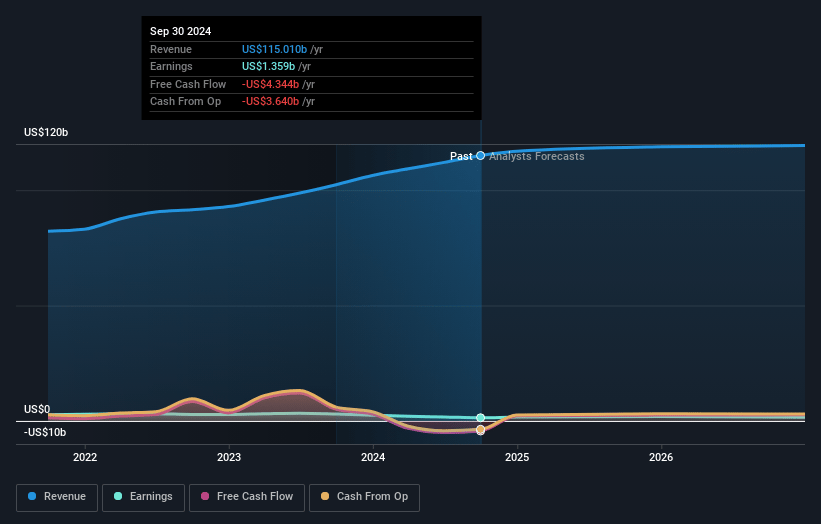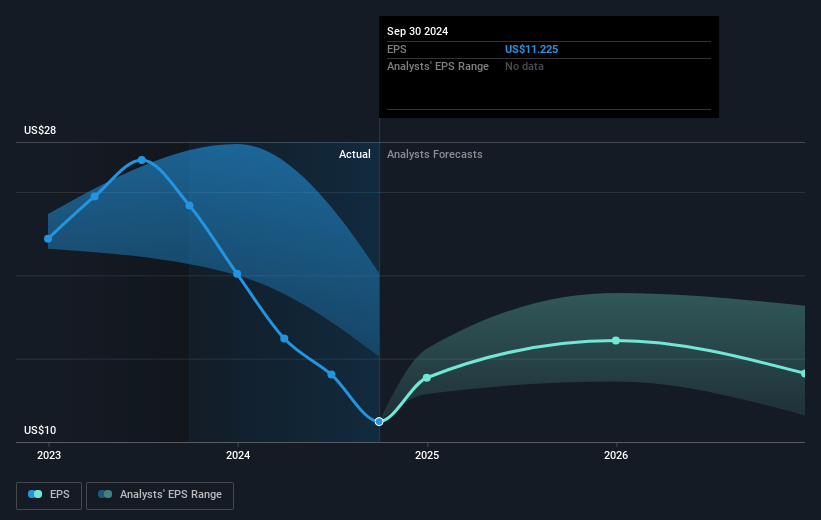Key Takeaways
- Enhanced AI use improves customer interactions and operational efficiency, potentially benefiting net margins and reducing costs.
- Strategic acquisitions and focus on clinical excellence boost growth in primary care, improve quality outcomes, and support revenue increase.
- Uncertainty around regulatory impacts and operational efficiency challenges could pressure Humana's margins and growth, necessitating strategic alignment to mitigate risks.
Catalysts
About Humana- Provides medical and specialty insurance products in the United States.
- Humana is focusing on operational efficiency by increasing the use of AI in its contact centers to enhance customer interactions and reduce costs, likely impacting net margins.
- The company is making substantial efforts to improve clinical excellence, including medication adherence campaigns and member engagement through in-home visits combined with virtual health, which is expected to enhance medical margins and member experience.
- Growth in value-based models, particularly through the expansion of CenterWell and Medicaid services, is contributing to robust year-over-year patient and membership growth, indicating a potential increase in revenue.
- Humana’s strategic capital allocation, including the acquisition of 30 new centers, is expected to fuel growth in primary care, impacting revenue and operational scalability.
- The progress in closing gaps in care and achieving high Stars ratings is targeted to deliver sustainable clinical outcomes and boost quality, contributing positively to future earnings and competitive stability.
Humana Future Earnings and Revenue Growth
Assumptions
How have these above catalysts been quantified?- Analysts are assuming Humana's revenue will grow by 5.9% annually over the next 3 years.
- Analysts assume that profit margins will increase from 1.4% today to 1.9% in 3 years time.
- Analysts expect earnings to reach $2.7 billion (and earnings per share of $22.97) by about May 2028, up from $1.7 billion today. However, there is some disagreement amongst the analysts with the more bearish ones expecting earnings as low as $2.2 billion.
- In order for the above numbers to justify the analysts price target, the company would need to trade at a PE ratio of 16.4x on those 2028 earnings, down from 17.8x today. This future PE is lower than the current PE for the US Healthcare industry at 19.7x.
- Analysts expect the number of shares outstanding to grow by 0.16% per year for the next 3 years.
- To value all of this in today's terms, we will use a discount rate of 6.26%, as per the Simply Wall St company report.
Humana Future Earnings Per Share Growth
Risks
What could happen that would invalidate this narrative?- Humana's performance is influenced by the Medicare Advantage (MA) Stars program, and uncertainties around litigation related to CMS' 2026 Star ratings could affect profitability and growth projections, impacting earnings.
- Timing-related outperformance and administrative cost expectations shifting to later quarters could potentially affect operational efficiency and net margins if not managed accurately.
- The impact of MACRA's V28 coding changes and its disproportionate effect on higher-acuity patients could pressure the company's medical cost ratio and affect overall margin if not successfully mitigated.
- Ongoing integration and earnings realization in the Medicaid and CenterWell business segments are essential, and any delays or inefficiencies in these objectives could impact revenue growth and net earnings.
- External factors such as changes in reimbursement rates, regulatory pressure, or shifts in consumer behavior influenced by the Inflation Reduction Act (IRA) may present risks to revenue streams and profitability if not well aligned with the company's operational and strategic plans.
Valuation
How have all the factors above been brought together to estimate a fair value?- The analysts have a consensus price target of $309.401 for Humana based on their expectations of its future earnings growth, profit margins and other risk factors. However, there is a degree of disagreement amongst analysts, with the most bullish reporting a price target of $402.23, and the most bearish reporting a price target of just $256.0.
- In order for you to agree with the analyst's consensus, you'd need to believe that by 2028, revenues will be $142.9 billion, earnings will come to $2.7 billion, and it would be trading on a PE ratio of 16.4x, assuming you use a discount rate of 6.3%.
- Given the current share price of $251.77, the analyst price target of $309.4 is 18.6% higher.
- We always encourage you to reach your own conclusions though. So sense check these analyst numbers against your own assumptions and expectations based on your understanding of the business and what you believe is probable.
How well do narratives help inform your perspective?
Disclaimer
AnalystConsensusTarget is a tool utilizing a Large Language Model (LLM) that ingests data on consensus price targets, forecasted revenue and earnings figures, as well as the transcripts of earnings calls to produce qualitative analysis. The narratives produced by AnalystConsensusTarget are general in nature and are based solely on analyst data and publicly-available material published by the respective companies. These scenarios are not indicative of the company's future performance and are exploratory in nature. Simply Wall St has no position in the company(s) mentioned. Simply Wall St may provide the securities issuer or related entities with website advertising services for a fee, on an arm's length basis. These relationships have no impact on the way we conduct our business, the content we host, or how our content is served to users. The price targets and estimates used are consensus data, and do not constitute a recommendation to buy or sell any stock, and they do not take account of your objectives, or your financial situation. Note that AnalystConsensusTarget's analysis may not factor in the latest price-sensitive company announcements or qualitative material.




